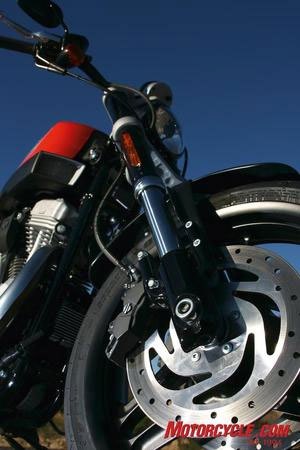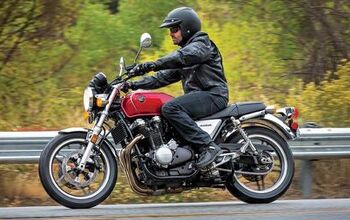Knowing How to Brake Saves (the Most) Lives
NOTE: This is a basic guide on manual braking for most motorcycles with separate front and rear brake circuits. A few bikes have integrated front/rear brakes or anti-lock brakes (ABS). If you have integrated brakes or ABS, some of this won’t apply. Insurance companies strongly endorse ABS. Studies have shown the number of fatal crashes and the severity of individual claims decrease significantly for riders of ABS-equipped bikes.
With braking, the use it or lose it principle definitely applies, and skills can become rusty if not proactively attended to.
Learning to brake better makes riding more fun and enjoyable, because you have better control. And becoming practiced at making hard stops may add to your peace of mind because your chances are at least improved for handling the unexpected.
Researchers have found that riders often panic in split-second traffic confrontations. One study showed that a panic state disabled riders’ conscious reactions and nearly a third of riders observed in an accident scenario simply froze: they didn’t even touch their brakes!
Don’t let this happen to you.
| Allstate Insurance On Rider Safety |
Our friends at Allstate Motorcycle Insurance know a thing or two about motorcycle safety. In addition to Motorcycle.com's safety series, Allstate Motorcycle Insurance has its own valuable safety information to share. * Motorcycle Awareness: Safety Tips from Allstate Motorcycle Insurance |
If you are a new rider, or have been off the bike for more than six months, you will want to carefully brush up on your braking abilities. Even experienced riders benefit from periodic braking drills, or an advanced rider class under the watchful eye of an instructor.
Most riders know the front brake does anywhere from 60-90 percent of their stopping. A longer wheelbase cruiser or touring bike tends to be on the lower end of this scale. A sport bike can completely lift the back wheel off the ground in some cases, which would mean the front brake in these examples is doing 100 percent of the braking.
The physics behind this is that when braking, the weight transfers forward, and pushes down onto the front tire’s contact patch improving its traction. At the same time the rear loses a proportional degree of traction. Motorcycles therefore usually have one or two larger brake discs up front and a smaller single disc in the rear.
Before providing tips on the act of braking itself, let’s take a minute to consider some other factors you will want to be mindful of:
Depending on road surface and temperature, your traction for braking – just as with cornering – can vary greatly.
When balancing on two small tires your margin of error is much slimmer, so “reading” pavement is a learned skill you will need to develop.
Experienced riders know that before deciding how hard to brake, they need to already have a sense about what kind of traction they think they have.
And as a further side note, part of this traction equation is a function of the tires. Are they new, half worn or nearly worn out? Are they sticky street racing tires, or harder compound long-mileage touring tires, or something in between?
You need to know your tires while also developing the skill of gauging what kind of pavement these tires have to bite into.
Asphalt can be old, new, smooth, rough, sandy, or littered with gravel. It can also be rippled, oily, and painted – as at intersections, where you typically need to stop, sometimes quickly.
Sometimes tar has been laid down to cover cracks. This, like oily or painted surfaces, is especially slippery when wet, and even when dry, these surfaces offer decreased grip.
Some roadways are made with concrete, which also grips differently (often worse than good asphalt).
Metal manhole covers, train and trolley tracks, and metal plates used in repairs are also something to watch out for.
So, aside from the fundamentals of braking 101, you will be well served to learn to continually scan and judge pavement conditions and quality.
Ok, now for some basics:
You naturally get “practice” every time you ride, but taking time to set up deliberate drills periodically, as mentioned, can make a big difference.
A secluded parking lot works. So can a side street (with no one following you) on which you can practice progressively harder stops.
You should brake with the front and rear brakes together. Ideally, you take them to near lock-up for hardest braking. If the rear (or front!) skids a little, back off.
As you develop sensitivity, both wheels can be taken to near lock up, and you especially want to master the front. Always take great care to work at your own comfort level. This is particularly true for braking while cornering.
Definitely learn how to brake while cornering, but be careful. Slick pavement, or sand, gravel or spilled oil can put you down in a millisecond if you brake too hard. In fact, if you know it is gravelly or sandy in a corner, avoid the brakes.
Another technique is to “cover” your brake. Basic rider classes may teach riders to use four fingers to pull the front brake lever. But experienced riders learn to ride with two or three fingers ready on the lever at all times. This can save nearly a whole second in reaction time, and that could mean much shorter stopping distances.
To calculate just how much sooner you could stop if you saved a second, use the conversion factor of 1 mph = 1.46 feet per second.
So, if you were traveling at 55 mph, you are doing 81 feet per second. Learning to decrease your reaction time by habitually covering the brake could theoretically stop you from 55 mph about six or seven car lengths sooner.
Likewise, if you were doing 35 mph, a second equals 51 feet saved in stopping distance, or about 4 cars lengths. If you were doing 80 mph, it would equal 117 feet per second, or more than a third of a football field.
In all, you want to practice enough until it’s second nature on a variety of pavement types, and a variety of speeds.
While there are no guaranties, developing your skills should give you an advantage. With braking, it is best to hope for the best, but to carefully and deliberately prepare yourself for everything else.
Jeff Cobb is the editor and publisher of Motorcycle Safety News. Comments, and questions can be directed to [email protected].
Related Reading
How Well Do You Know Your Motorcycle?
Rider Education, Injuries and Fatalities
What to Wear When You Ride - and Why
The SEE System: Increasing Your Visibility
Motorcycle Insurance Basics
Choose a Motorcycle That Fits
The American Culture of Motorcycle Safety
Group Riding 101
Should You Ride a Motorcycle?
How to Load Your Motorcycle
Night Riding
Riding With a Passenger
Riding in the Rain and Wind
The Truth about Drinking and Riding
Road Conditions Quiz
More by Jeff Cobb





























Comments
Join the conversation